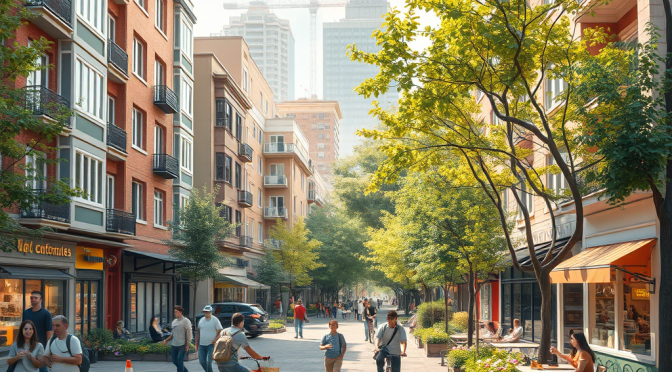The 15-minute city is an urban planning concept centered on creating cities where residents can meet their daily needs within a 15-minute walk or bike ride from their homes. This idea, popularized by urban planner Carlos Moreno, envisions neighborhoods that are self-sufficient, compact, and multifunctional, offering a mix of residential, commercial, and recreational spaces.
This concept has gained traction in recent years as cities around the world grapple with challenges like urban sprawl, traffic congestion, and environmental sustainability. The 15-minute city proposes a paradigm shift in how we design urban spaces, prioritizing accessibility, community, and environmental well-being over traditional car-centric development.
Core Principles of the 15-Minute City
The 15-minute city is built on six core principles:
- Proximity: Essential services such as healthcare, education, grocery stores, and leisure facilities should be within a short walking or cycling distance from where people live.
- Diversity: A mix of housing types, businesses, and cultural activities ensures vibrant, multifunctional neighborhoods.
- Density: Adequate population density supports efficient public transportation and local businesses while avoiding overcrowding.
- Ubiquity of Green Spaces: Parks, green corridors, and recreational spaces are integral for improving air quality and enhancing mental health.
- Active Mobility: Infrastructure prioritizes walking, cycling, and public transport over private car use.
- Community Engagement: Residents have a say in shaping their local environments, fostering a sense of ownership and belonging.
How 15-Minute Cities Transform Human Society
The implementation of 15-minute cities has far-reaching implications for various aspects of society:
1. Environmental Benefits
By reducing the reliance on cars, 15-minute cities aim to decrease greenhouse gas emissions and air pollution. With more people walking or cycling, urban areas can reduce their carbon footprint and combat climate change. Additionally, increasing green spaces helps in managing urban heat islands and improving biodiversity.
2. Health and Well-being
Active mobility encourages healthier lifestyles, reducing rates of obesity, diabetes, and heart disease. Proximity to amenities reduces stress associated with long commutes, while green spaces offer mental health benefits by providing residents with places to relax and connect with nature.
3. Economic Resilience
By supporting local businesses and reducing dependency on large-scale infrastructure, 15-minute cities foster economic resilience. Small businesses thrive when communities are designed to encourage foot traffic, and decentralized economies become less vulnerable to global supply chain disruptions.
4. Social Cohesion
Compact, mixed-use neighborhoods facilitate stronger social bonds. When people live, work, and play in the same area, opportunities for community interaction increase, reducing feelings of isolation and promoting inclusivity.
5. Equity and Accessibility
15-minute cities aim to make essential services accessible to everyone, regardless of socioeconomic status. By emphasizing walkability and public transportation, these cities provide greater mobility for people who cannot afford private vehicles.
Challenges and Criticisms
While the 15-minute city offers numerous advantages, its implementation is not without challenges. Critics argue that:
- Urban Inequities May Persist: Wealthier neighborhoods might adopt the concept more quickly, leaving underprivileged areas behind.
- Gentrification Risks: Improved urban areas may lead to rising property values, pushing out lower-income residents.
- Logistical Hurdles: Retrofitting existing cities to fit this model can be costly and complex, requiring significant political will and public support.
- Cultural Barriers: In car-dependent societies, shifting mindsets toward active mobility can be difficult.
Case Studies: Cities Leading the Way
Several cities are already embracing the 15-minute city concept:
- Paris, France: Under Mayor Anne Hidalgo, Paris has implemented measures to reduce car use, enhance cycling infrastructure, and create multifunctional neighborhoods.
- Melbourne, Australia: The city’s Plan Melbourne initiative incorporates 20-minute neighborhoods as a central pillar.
- Portland, USA: Portland has long championed walkable neighborhoods and compact urban design.
- Copenhagen, Denmark: Known for its cycling culture and green urban spaces, Copenhagen exemplifies many principles of the 15-minute city.
A Future Worth Striving For
The 15-minute city is more than just an urban planning trend—it represents a holistic approach to creating sustainable, livable, and equitable cities. By prioritizing proximity, community, and environmental stewardship, it offers a blueprint for addressing the interconnected challenges of urbanization, climate change, and social well-being.
As cities around the world continue to grow, embracing the 15-minute city model could be a transformative step toward a more sustainable and human-centered future. While the path to implementation may be complex, the potential rewards—healthier people, thriving communities, and a cleaner planet—make it a goal worth pursuing.
